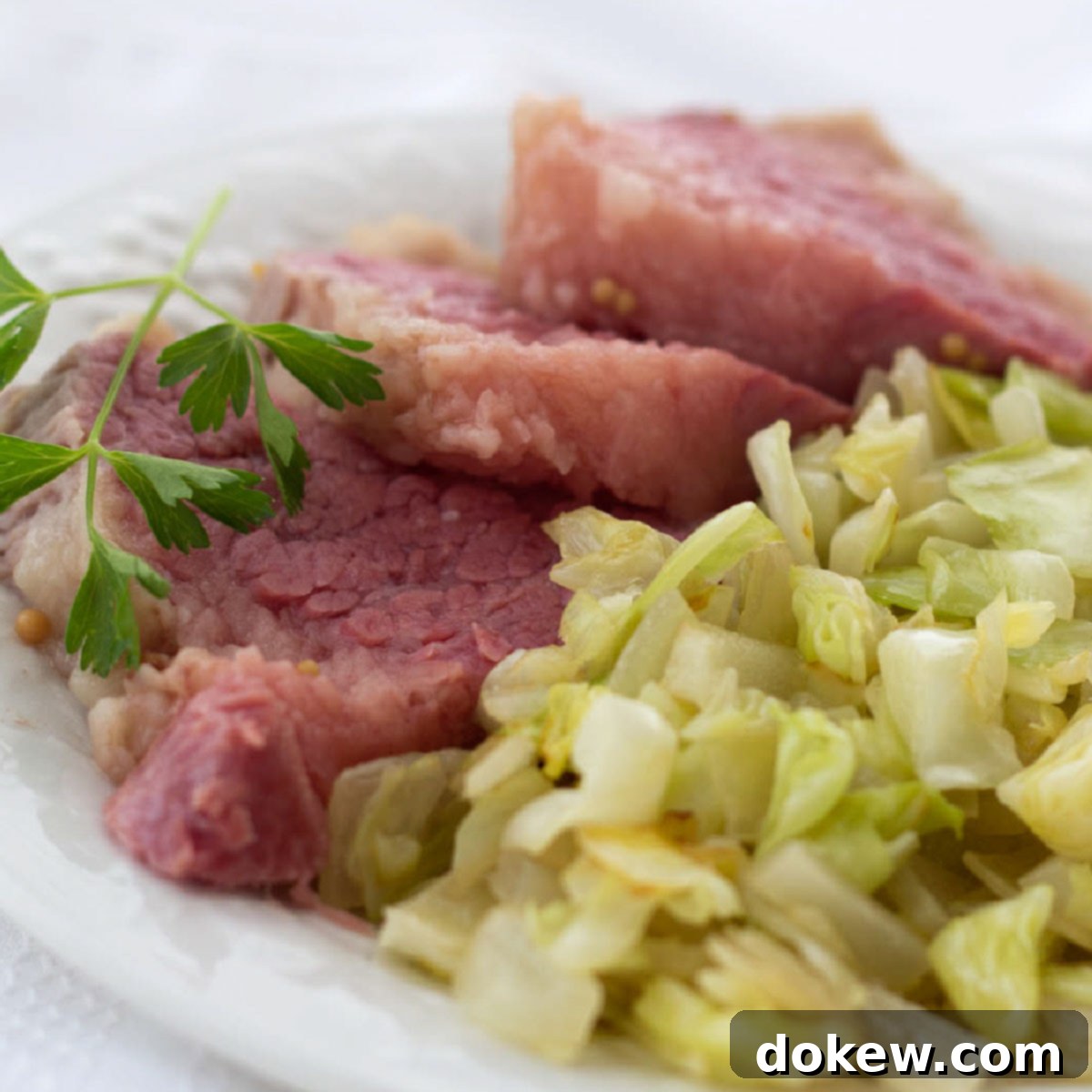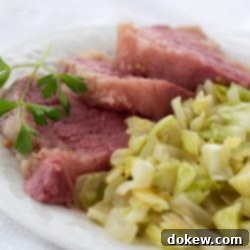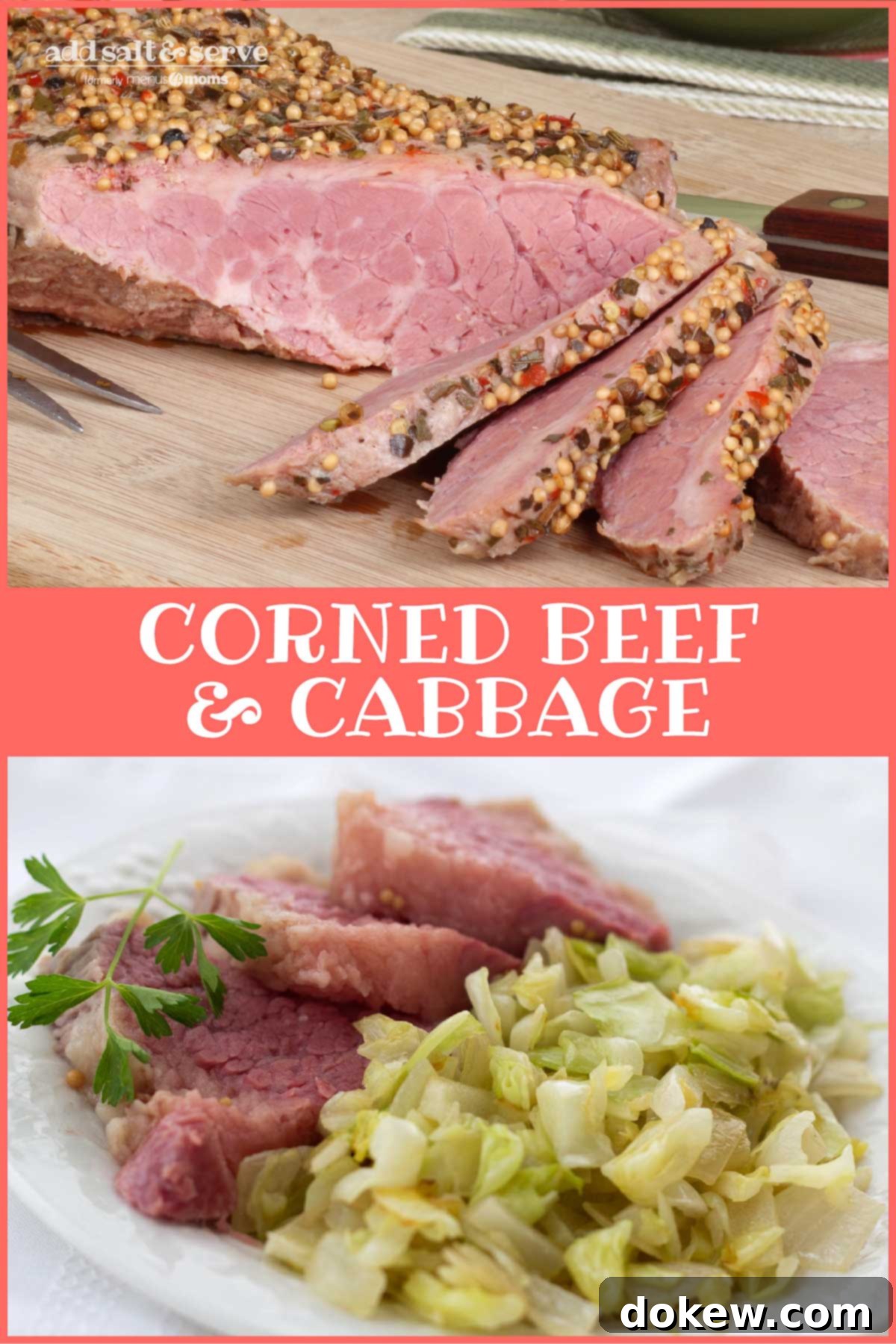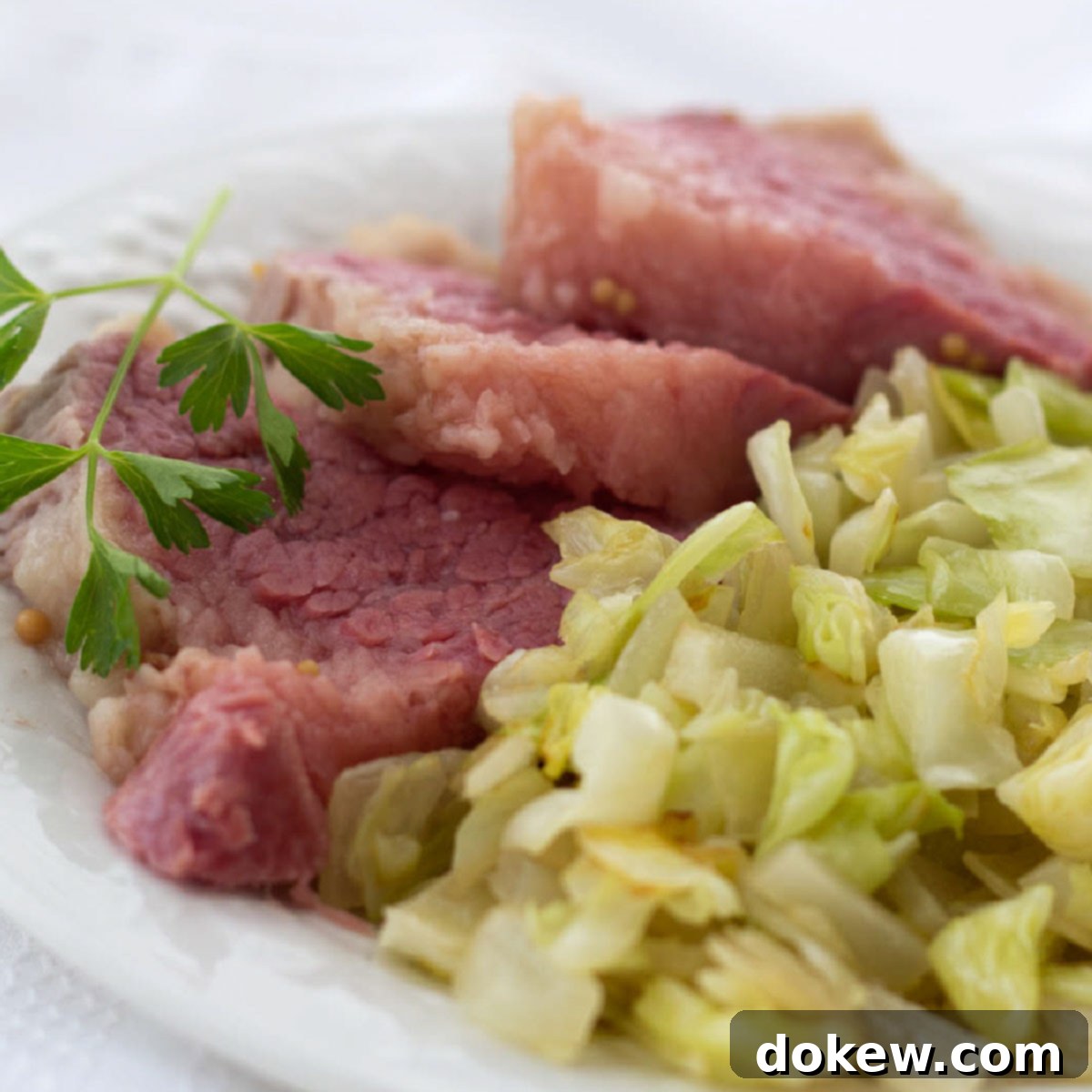Classic Corned Beef and Cabbage Recipe: Stovetop or Slow Cooker Perfection
There are few dishes as satisfying and full of robust flavor as perfectly cooked corned beef and tender cabbage. This classic combination is a hearty meal that brings warmth and comfort to any table, whether you’re celebrating St. Patrick’s Day or simply craving a delicious, easy-to-prepare dinner. Its tender beef and savory vegetables create a harmonious blend that’s both deeply flavorful and incredibly comforting. Plus, it’s a fantastic dish for meal prepping, as any leftovers can be transformed into amazing Reuben sandwiches the next day – a culinary treat you won’t want to miss! Trust us, you might even want to double the recipe, because this meal is so good, you might not have many leftovers to begin with!

[feast_advanced_jump_to]
Why You’ll Love This Easy Corned Beef and Cabbage Recipe
This corned beef and cabbage recipe is more than just a meal; it’s an experience in flavor and simplicity. Here’s why it’s bound to become a favorite in your kitchen:
- **Incredibly Tender & Flavorful:** The slow cooking process, whether on the stovetop or in a crockpot, ensures the corned beef brisket becomes fall-apart tender, absorbing all the aromatic spices.
- **Versatile Cooking Methods:** Choose between the classic stovetop method for a quicker cook or the set-it-and-forget-it convenience of a slow cooker. Both yield fantastic results!
- **Budget-Friendly & Hearty:** Corned beef is often an economical cut of meat, and paired with inexpensive cabbage, it makes for a filling and satisfying meal without breaking the bank.
- **Perfect for Leftovers:** Beyond being a delicious standalone meal, the leftovers are incredibly versatile. Transform them into delectable Reuben sandwiches, hearty corned beef hash, or even a savory stew.
- **Simple Ingredients:** With just a few core ingredients, this recipe proves that you don’t need a complicated list to create a truly memorable dish.
- **Ideal for Gatherings:** Whether for a holiday like St. Patrick’s Day or a family dinner, this dish scales easily to feed a crowd and is sure to impress.
⏲️ Cooking Time Overview
The time required to achieve perfectly tender corned beef varies depending on your chosen cooking method. For the traditional **stovetop method**, you’ll need approximately **3 hours** of simmering. If you opt for the convenience of a **crockpot (slow cooker)**, allow up to **5-6 hours** on high or 8-10 hours on low for the beef to become wonderfully tender.
🥘 Essential Ingredients for Classic Corned Beef and Cabbage
Crafting this savory corned beef and cabbage dish requires just a few simple, high-quality ingredients. Here’s what you’ll need to gather:
- **Corned Beef Brisket with Spice Packet:** This is the star of our dish. Look for a corned beef brisket, which is a beef cut from the breast or chest, typically found cured and pre-packaged. Most briskets come with a small spice packet – *do not discard this!* It contains the essential pickling spices that give corned beef its distinctive aroma and flavor. You can usually choose between a “flat cut” (leaner, easier to slice) or a “point cut” (more marbled, fattier, and often more tender).
- **Chopped Onions:** Onions add a foundational layer of sweetness and aromatic depth to the broth as the beef cooks, slowly caramelizing and contributing to the overall flavor profile.
- **Chopped Cabbage:** A quintessential partner to corned beef, cabbage cooks down to a tender, slightly sweet state, absorbing the rich flavors of the beef broth and spices. Green cabbage is most commonly used for this dish.
Optional Additions for a Complete Meal:
While the core ingredients are simple, you can enhance your meal by adding other root vegetables alongside the cabbage and onions:
- **Carrots:** Adds sweetness and color, often becoming melt-in-your-mouth tender.
- **Potatoes:** Small red or Yukon Gold potatoes, quartered, make this a true one-pot meal, cooking directly in the flavorful broth and absorbing all the delicious juices.
- **Celery:** Another aromatic that adds depth and subtle flavor to the cooking liquid.
- **Bay Leaves (extra):** If your spice packet feels sparse, a few extra bay leaves can boost the aromatic complexity.
📋 Detailed Cooking Instructions for Perfect Corned Beef and Cabbage
This corned beef brisket can be prepared using two popular methods: the traditional stovetop simmering or the convenient slow cooker method. Both will yield incredibly tender and flavorful results, allowing you to choose based on your schedule and preference.
Stovetop Method: Achieving Tenderness on the Hob
The stovetop method is a classic choice for cooking corned beef, allowing for precise temperature control and a relatively quicker cooking time of about 3 hours. Follow these steps for a perfectly tender brisket:
- Prepare the Brisket: Begin by carefully unwrapping your corned beef brisket. Place it into a large, heavy-bottomed pot or Dutch oven. Ensure the pot is large enough to comfortably hold the brisket and enough water to cover it completely without overflowing.
- Add Liquid and Spices: Pour enough cold water into the pot to fully submerge the brisket. Open the accompanying spice packet and sprinkle its contents evenly over the beef. The spices typically include bay leaves, peppercorns, mustard seeds, and coriander, which infuse the meat with its characteristic flavor during cooking.
- Bring to a Simmer: Cover the pot with a tight-fitting lid and bring the water to a rolling boil over high heat. Once boiling, immediately reduce the heat to low, maintaining a gentle, consistent simmer. It’s crucial not to boil vigorously, as this can toughen the meat and make it dry.
- Slow Simmer for Tenderness: Allow the brisket to simmer gently for approximately **three hours**. The key to achieving tender, melt-in-your-mouth corned beef is this low and slow cooking process. While an internal beef temperature of at least 160ºF (71ºC) indicates doneness, cooking it longer to 190-205°F (88-96°C) will ensure maximum tenderness and a fork-shredding texture.
- Add Vegetables: In the **last 15-30 minutes of cooking**, add your chopped onions and cabbage to the pot. If you are also adding harder root vegetables like carrots or potatoes, you might add them slightly earlier (e.g., 45-60 minutes before the end of cooking) as they require more time to soften than cabbage. Continue to cook until all vegetables are tender-crisp or to your desired softness.
- Rest and Serve: Once the brisket is wonderfully tender, carefully remove it from the pot and transfer it to a cutting board. Let it rest for 10-15 minutes before slicing. This resting period is vital as it allows the juices to redistribute throughout the meat, ensuring a moist and flavorful cut. Slice the corned beef against the grain for the most tender pieces. Serve immediately with the cooked vegetables and a generous ladleful of the flavorful cooking broth.
Crockpot (Slow Cooker) Method: Effortless Perfection
For a hands-off approach that’s perfect for busy days, the slow cooker delivers exceptionally tender corned beef with minimal effort. This method takes longer but requires very little supervision throughout the cooking process:
- Place Brisket: Begin by placing the corned beef brisket into your crockpot. Ensure it’s a size that fits comfortably within the cooker.
- Cover with Water and Spices: Pour enough cold water over the brisket to cover it completely. Add the entire contents of the spice packet that came with your corned beef.
- Slow Cook to Perfection: Cover the crockpot with its lid and cook on **HIGH for 5-6 hours**, or on **LOW for 8-10 hours**. The goal is for the beef to be fork-tender. While an internal temperature of 160ºF (71ºC) is a safe internal temperature, cooking it longer, often up to 190-205°F (88-96°C), will result in that desirable melt-in-your-mouth texture that makes corned beef so special.
- Introduce Vegetables: Approximately **one hour before serving**, add the chopped cabbage and onions (and any other optional root vegetables like carrots or potatoes) to the crockpot. Gently push them down into the liquid so they can absorb the rich flavors. Continue cooking until the vegetables are tender, absorbing the delicious essence from the broth.
- Rest and Slice: Once cooked and tender, carefully remove the brisket from the slow cooker and transfer it to a cutting board. Allow it to rest for 10-15 minutes. This rest is crucial for retaining moisture and flavor. Slice the corned beef against the grain to ensure maximum tenderness before serving with the accompanying tender vegetables and a drizzle of the cooking liquid.
❓ Frequently Asked Questions About Corned Beef
Corned beef is a fascinating and delicious dish with a rich history. Here are some common questions and answers to help you understand it better and prepare it to perfection:
What cut of meat is corned beef made from?
Corned beef is primarily made from **beef brisket**. The brisket is a boneless cut of beef taken from the breast or lower chest of the cow. This cut is naturally tough and fibrous, with a good amount of connective tissue, making it an ideal candidate for slow cooking methods. Slow simmering breaks down these tough fibers and connective tissues into gelatin, resulting in an incredibly tender, flavorful piece of meat.
What does “corned” mean in corned beef?
The term “corned” in corned beef refers to the traditional method of curing the beef. Historically, large grains of rock salt, which were often called “corns” (similar to grains of corn), were used to preserve the meat. Essentially, corned beef is a **salt-cured beef product**. The distinct, savory flavor of corned beef comes from this two-part process: first, the extensive salt curing (brining) process, and second, the aromatic seasoning from the spice packet that is added during cooking. This combination creates a unique taste profile unlike any other beef preparation.
Is Corned Beef truly Irish?
The perception of corned beef as a traditionally Irish dish, especially in the U.S., is a bit nuanced and the subject of some culinary debate. While Ireland did become a major exporter of salt-cured beef in the 17th century, partly due to its thriving cattle industry and a lower salt tax compared to England, the Irish people themselves rarely ate it. They primarily raised cattle for dairy and only ate beef from older, culled cows, which was considered a luxury. The highly valued cured beef was largely for export, particularly to the British Navy and colonies.
By the early 20th century, however, corned beef became very popular among Irish immigrants in the U.S. It was a more affordable and readily available alternative to the pork and bacon they ate in Ireland, which was often more expensive in their new homeland. They frequently found a steady and inexpensive supply of this cured meat from Jewish butchers in American cities, where Jewish communities also had a tradition of curing beef (leading to dishes like pastrami and kosher brisket). So, while its origins as a culinary staple *for* the Irish are not in Ireland itself, it became a significant and cherished part of Irish-American culinary tradition.
(Source)
What is typically in the spice packet that comes with corned beef?
The spice packet is essentially a blend of **pickling spices**, designed to enhance the flavor of the beef during its long simmer. While the exact contents can vary slightly between brands and recipes, you’ll commonly find a fragrant mix of whole spices. These usually include: **bay leaves, black peppercorns, mustard seeds (often brown or yellow), dill seeds, and coriander seeds**. Other aromatic herbs and seeds such as whole cloves, allspice berries, and sometimes a pinch of red pepper flakes might also be included to add a gentle warmth and complexity to the overall flavor profile. These spices are crucial for achieving that characteristic corned beef taste.
Why is my cooked corned beef brown instead of red?
The color of your cooked corned beef depends primarily on the curing agents used. If the beef package you purchased was cured **without nitrates or nitrites**, the resulting cooked roast will naturally be brown or grayish-brown, much like any other cooked pot roast. Nitrates and nitrites are specific chemical additives used in the curing process that react with the myoglobin (the protein responsible for meat’s red color) in the meat. This reaction “fixes” the pinkish-red color, preserving it even after cooking. Both methods are safe to consume; the color difference is purely aesthetic and indicative of the curing method chosen by the producer.
Should I rinse the corned beef brisket before cooking?
Rinsing the corned beef brisket before cooking is an optional step. It’s generally **not necessary** for food safety or to develop good flavor. An unrinsed roast will often be more flavorful due to the residual curing salts and spices on the surface, which further season the cooking liquid. However, if you typically find store-bought corned beef to be too salty for your taste, or if you are specifically trying to reduce your sodium intake, you can certainly give it a quick, thorough rinse under cold water before cooking. Some even soak it in fresh water for an hour or two (changing the water once or twice) to further draw out excess salt. Always remember to pat it dry if you rinse it, especially if you plan to sear it first (though searing is not typical for traditional boiled corned beef).
Is the thick liquid in the package normal?
Yes, the liquid found in the corned beef package often appears somewhat thick or gel-like, and this is completely normal. This is typically a brine solution (salt water) combined with natural proteins and gelatin that have leached out of the meat during the curing process. This consistency by itself **does not indicate that the meat has gone bad**. To ensure freshness and safety, always pay attention to any “use by” dates on the package (which are distinct from “best by” dates, which refer to quality rather than safety).
How should I slice corned beef for serving?
For the most tender and enjoyable results, always slice cooked corned beef **against the grain**. The “grain” refers to the direction of the visible muscle fibers within the meat. By slicing perpendicular to these lines, you effectively shorten these long, tough fibers, making the meat much easier to chew and giving it a more tender texture. If you slice with the grain, the meat can be tough and stringy.
Can I prepare corned beef and cabbage ahead of time?
Yes, absolutely! Corned beef and cabbage is one of those wonderful dishes that often tastes even better the next day, as the flavors have more time to meld and deepen. You can cook the entire dish, then allow it to cool completely. Store the beef and vegetables in separate airtight containers in the refrigerator for up to 3-4 days. The flavorful broth can also be stored separately. This makes it an excellent option for meal prep, busy weeknights, or for feeding a crowd without last-minute stress.
Recipe Card: Easy Corned Beef and Cabbage

Corned Beef and Cabbage
Add to Shopping ListGo to Shopping List
Ingredients
- 3 lb corned beef brisket with spice packet
- 2 onions, chopped (medium size)
- 1 head cabbage, chopped into wedges or large pieces
- Optional: 2-3 medium carrots, peeled and chopped into large chunks
- Optional: 2-3 medium potatoes, scrubbed and quartered (e.g., red or Yukon Gold)
Instructions
Stovetop Instructions:
-
Prepare Brisket: Place the corned beef brisket into a large, heavy-bottomed pot or Dutch oven and cover completely with cold water. Add the contents of the spice packet.
-
Simmer: Cover the pot and bring to a rolling boil over high heat, then reduce heat to low, maintaining a gentle simmer.
-
Cook until Tender: Simmer for approximately three hours, or until the brisket is fork-tender (internal beef temperature should be at least 160ºF).
-
Add Vegetables: In the last 15-30 minutes of cooking, add the chopped onions and cabbage (and optional carrots/potatoes, adding them 45-60 mins before the end). Cook until all vegetables are tender.
-
Rest & Serve: Remove brisket, let rest 10-15 minutes, then slice against the grain. Serve with cooked vegetables and broth.
Crockpot (Slow Cooker) Instructions:
-
Prepare Brisket: Place the corned beef brisket into your crockpot and cover completely with cold water. Add the spice packet.
-
Slow Cook: Cover and cook on HIGH for 5-6 hours, or on LOW for 8-10 hours, until the brisket is fork-tender (internal beef temperature at least 160ºF).
-
Add Vegetables: About one hour before serving, add the chopped cabbage, onions, and any other optional root vegetables to the crockpot. Continue cooking until the vegetables are tender.
-
Rest & Slice: Carefully remove the brisket, let it rest for 10-15 minutes, then slice against the grain. Serve with the tender vegetables.
Nutrition per serving
Share
Pin
Tips for the Best Corned Beef and Cabbage
Follow these expert tips to ensure your corned beef and cabbage turns out perfectly every time:
- **Choose the Right Cut:** While flat cut brisket is leaner and slices nicely, point cut brisket often yields a more tender and flavorful result due to its higher fat content. Either works beautifully with slow cooking.
- **Don’t Overcook the Cabbage:** Cabbage cooks relatively quickly. Add it towards the end of the beef’s cooking time (as specified in the instructions) to ensure it’s tender-crisp and not mushy. Mushy cabbage can detract from the dish.
- **Slice Against the Grain:** For maximum tenderness and ease of eating, always slice the cooked corned beef brisket against the grain of the meat fibers. Identify the direction of the muscle fibers and slice perpendicular to them.
- **Rest the Meat:** After cooking, it’s crucial to let the corned beef rest on a cutting board for 10-15 minutes before slicing. This allows the juices to redistribute throughout the meat, resulting in a moister and more flavorful slice.
- **Don’t Discard the Broth:** The cooking liquid (broth) is incredibly flavorful, infused with the essence of the beef and spices! It’s excellent for serving with the corned beef and vegetables, or you can save it for making a hearty soup, a base for corned beef hash, or simply as a flavorful stock.
- **Adjust Saltiness:** If you find store-bought corned beef too salty for your preference, you can rinse it well under cold water before cooking. For a significant reduction in sodium, you can even soak the brisket in fresh water for an hour or two (changing the water once or twice).
- **Add More Vegetables:** Feel free to customize your meal by adding other root vegetables like parsnips, turnips, or more potatoes and carrots to the pot for a more substantial and colorful meal. Just adjust their cooking time based on hardness.
- **Serving Temperature:** Serve the corned beef and cabbage hot. The rich flavors are best enjoyed when the dish is warm.
🥗 What to Serve with Classic Corned Beef and Cabbage
While corned beef and cabbage is a complete and satisfying meal on its own, certain side dishes and condiments can elevate the experience and add delightful contrasts to its rich flavors:
- **Potatoes:** Creamy mashed potatoes, hearty roasted potatoes, or simply boiled potatoes (often cooked in the same pot as the beef, absorbing the broth’s flavor) are classic and beloved accompaniments. The starch perfectly balances the rich, salty beef.
- **Rustic Bread:** A crusty bread is wonderful for soaking up the flavorful broth. Consider a traditional Irish Guinness Brown Bread, a simple soda bread, or a crusty baguette.
- **Mustard:** A good quality coarse-grain mustard or a spicy brown mustard offers a tangy and pungent counterpoint to the richness of the beef, enhancing its flavor profile.
- **Horseradish Sauce:** For those who enjoy a bit of a kick, a creamy horseradish sauce is a fantastic pairing that cuts through the richness of the corned beef beautifully.
- **Additional Steamed Vegetables:** If you didn’t cook all your vegetables in the pot, a side of fresh green beans or asparagus can add a light, crisp element.
- **Pickled Beets:** The earthy sweetness and tang of pickled beets can be a surprising but delightful addition, offering a vibrant color and flavor contrast.
Storage and Reheating Tips for Delicious Leftovers
One of the best things about corned beef and cabbage is how wonderfully it keeps, making it perfect for meal prep or enjoying delicious leftovers for days:
- **Storage:** Allow the cooked corned beef and vegetables to cool completely to room temperature (within two hours of cooking). Store them in separate airtight containers in the refrigerator for up to 3-4 days. The flavorful cooking broth can also be stored separately and makes a great base for future soups or gravies.
- **Reheating:**
- Microwave: For individual servings, reheat sliced corned beef and vegetables in the microwave until warmed through. Be careful not to overcook the beef, as it can dry out quickly. Adding a splash of the reserved broth before microwaving can help retain moisture.
- Stovetop: Gently reheat the sliced corned beef and vegetables in a pot with a splash of the reserved cooking liquid (broth) over low to medium heat until hot. This is often the best method for maintaining moisture and tenderness.
- Oven: For larger quantities or if you prefer not to microwave, place the beef and vegetables in an oven-safe dish with a little broth, cover with aluminum foil, and reheat in a preheated oven at 300°F (150°C) until warm (about 20-30 minutes, depending on quantity).
- **Creative Leftovers:** Don’t let those tasty remnants go to waste! Get creative with your corned beef leftovers:
- **Reuben Sandwiches:** The most famous use for leftover corned beef! Pile sliced beef, sauerkraut, Swiss cheese, and creamy Russian or Thousand Island dressing on rye bread, then grill until cheese is melted and bread is toasted.
- **Corned Beef Hash:** Chop leftover corned beef and potatoes (if you cooked them separately or have extras), then pan-fry with diced onions until crispy and golden. Top with a fried egg for a classic breakfast or brunch.
- **Corned Beef Soup:** Use the flavorful cooking broth as a base, add chopped leftover beef and vegetables, and simmer with extra stock, diced potatoes, and seasonings for a hearty and warming soup.
- **Corned Beef & Cabbage Rolls:** Finely chop the beef and cabbage, mix with a little broth, and use as a filling for savory pastry rolls.
Final Thoughts on This Hearty Corned Beef Meal
This classic corned beef and cabbage recipe is a testament to how simple ingredients, when cooked with care and patience, can transform into an incredibly comforting and profoundly flavorful meal. Whether you prefer the traditional stovetop method or the set-it-and-forget-it ease of a slow cooker, the result is always a tender, spice-infused brisket paired perfectly with sweet, soft cabbage. It’s a dish that embodies the spirit of home cooking, offering warmth, deep satisfaction, and delicious possibilities for leftovers that are arguably just as good as the original meal.
We encourage you to gather your ingredients, choose your preferred cooking method, and get ready to enjoy a timeless favorite that will surely become a cherished staple in your culinary repertoire. Don’t forget to share your creation with loved ones and spread the joy of this wonderful dish!

Source: Mac Con Iomaire, M. and P. Gallagher (2011) “Irish Corned Beef: A Culinary History,” Journal of Culinary Science and Technology, Vol 9, No. 1, accessed 21 February 2020.
